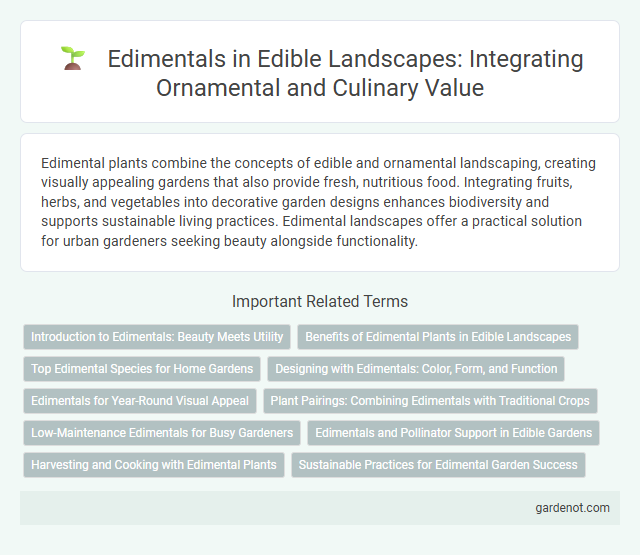Edimental plants combine the concepts of edible and ornamental landscaping, creating visually appealing gardens that also provide fresh, nutritious food. Integrating fruits, herbs, and vegetables into decorative garden designs enhances biodiversity and supports sustainable living practices. Edimental landscapes offer a practical solution for urban gardeners seeking beauty alongside functionality.
Introduction to Edimentals: Beauty Meets Utility
Edimentals are plants that combine edible qualities with ornamental beauty, enhancing both garden aesthetics and culinary options. These species offer a sustainable approach to landscaping by providing nutritious, flavorful foods alongside vibrant foliage and flowers. Cultivating edimentals transforms gardens into productive spaces where beauty meets utility seamlessly.
Benefits of Edimental Plants in Edible Landscapes
Edimental plants enhance edible landscapes by providing dual-purpose greenery that is both aesthetically pleasing and nutritionally valuable, contributing to sustainable urban agriculture. Their incorporation increases biodiversity, supports pollinators, and reduces the need for chemical inputs, promoting eco-friendly gardening practices. These plants offer unique flavors and textures, enriching culinary experiences while maximizing space efficiency in residential and commercial landscapes.
Top Edimental Species for Home Gardens
Edimental plants combine ornamental beauty with edible benefits, ideal for sustainable home gardens. Top edimental species include Physalis alkekengi (Chinese lantern), Rosmarinus officinalis (rosemary), and Tagetes patula (marigold), offering vibrant flowers and flavorful leaves. Incorporating these species enhances garden aesthetics while providing nutritious, versatile ingredients for culinary use.
Designing with Edimentals: Color, Form, and Function
Designing with edimentals involves integrating colorful, visually appealing edible plants that combine aesthetic form with culinary function. Utilizing native and unusual species enhances biodiversity while providing vibrant textures and flavors. Strategic placement maximizes sun exposure and ease of harvest, ensuring the edible landscape is both productive and decorative.
Edimentals for Year-Round Visual Appeal
Edimentals, a key element in edible landscapes, provide year-round visual appeal by combining functionality with aesthetics through perennial edible plants. Their diverse foliage colors, textures, and seasonal blooms create dynamic garden compositions that sustain interest beyond growing seasons. Integrating edimentals enhances sustainable gardening by supporting biodiversity while offering continuous harvests and ornamental beauty.
Plant Pairings: Combining Edimentals with Traditional Crops
Edimentals thrive when paired with traditional crops, enhancing biodiversity and improving soil health through complementary planting strategies. Combining nutrient-accumulating edimental species like borage or nasturtium with staple vegetables such as tomatoes or beans promotes pest deterrence and increased yields. Strategic plant pairings also optimize space and resource use, creating resilient and productive edible landscapes.
Low-Maintenance Edimentals for Busy Gardeners
Low-maintenance edimentals such as perennial herbs, kale, and berry bushes provide busy gardeners with nutrient-rich, edible plants that require minimal care. These resilient species thrive with limited watering and fertilization, making them ideal for sustainable urban gardens and small backyard plots. Incorporating edimentals reduces garden upkeep while enhancing biodiversity and food security.
Edimentals and Pollinator Support in Edible Gardens
Edimentals, edible and medicinal plants, play a vital role in supporting pollinators within edible landscapes by providing essential nectar and pollen resources. Incorporating diverse Edimentals such as borage, calendula, and fennel enhances pollinator habitats, improving biodiversity and crop yields. Cultivating Edimentals in edible gardens fosters sustainable ecosystems that benefit bees, butterflies, and other pollinators crucial for plant reproduction and food production.
Harvesting and Cooking with Edimental Plants
Harvesting edimental plants at peak ripeness ensures maximum flavor and nutritional value, with common choices including purslane, sorrel, and dandelion greens. Cooking methods like sauteing, steaming, or incorporating raw leaves in salads preserve delicate vitamins and enhance their natural taste profiles. Utilizing these plants in recipes not only promotes sustainability but also introduces unique textures and flavors to everyday meals.
Sustainable Practices for Edimental Garden Success
Edimental gardens thrive by integrating sustainable practices such as crop rotation, organic fertilization, and water-efficient irrigation techniques, which enhance soil health and reduce environmental impact. Utilizing native edible plants and companion planting promotes biodiversity and natural pest control, fostering resilient and productive edible landscapes. Emphasizing local seed varieties and minimizing chemical inputs ensure long-term ecological balance and garden sustainability.
Edimental Infographic

 gardenot.com
gardenot.com